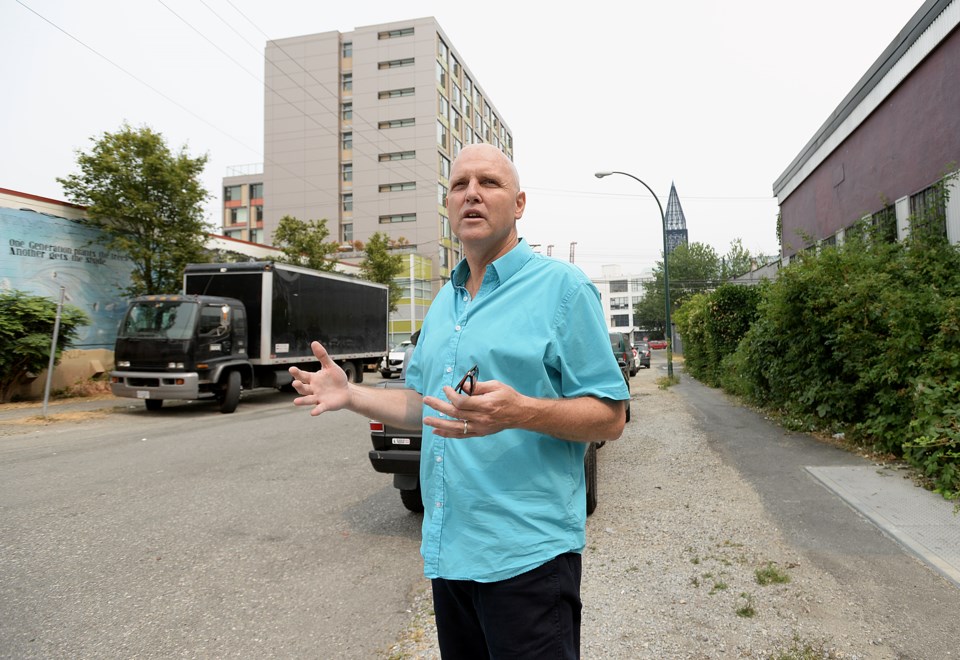The number of people counted over two days in March living on the street in Vancouver decreased slightly over a previous homeless count done in March 2014, the CEO of B.C. Housing said Monday.
But Shayne Ramsay wouldn’t reveal statistics on the homeless population, saying he didn’t want to “steal the thunder” of the city’s chief housing director, Mukhtar Latif, who is to deliver a full report on this year’s count to city council Tuesday.
“Sheltered homeless is about the same,” said Ramsay, referring to the number of people who have sought refuge in a shelter or a form of temporary accommodation until permanent housing is available.
Statistics for 2014 showed Vancouver’s homeless population reached its highest overall level in history, with 1,267 people living in some form of shelter and 536 on the street for a grand total of 1,803 people.
Ramsay made the comments after taking reporters on a tour of several B.C. Housing buildings in the Downtown Eastside, including some of the 13 single-room-occupancy hotels under renovation, a 147-unit complex for women and families and an innovative project that turned the former remand centre on Cordova Street into a mix of affordable and supportive housing.
Ramsay denied his unprecedented walkabout with reporters was tied to the release of this year’s homeless count statistics, which often end in Vancouver city council pointing the finger at the provincial and federal governments for not doing enough to address homelessness.
Ramsay said he recently gave the same tour to Housing Minister Rich Coleman’s director of communications, who was impressed with the breadth of the investment in housing and programs in the Downtown Eastside, which is where the city’s homeless population is traditionally the largest. That tour triggered the walkabout, he added.
“It’s just an opportunity to tell that story, and what better way to do it than on the ground when you’re walking around the neighbourhood,” he said from a boardroom inside a B.C. Housing satellite building on East Hastings.
Vision Vancouver Coun. Kerry Jang, who has been his party’s point person for the mental health and homelessness files, said Monday he hadn’t seen the statistics for this year’s count. But Jang said he was encouraged by news of a decrease in the homeless population.
“What it means is that we’re holding our own against homelessness,” said Jang, who attended the opening Monday of a 110-unit B.C. Housing-funded building at 1249 Howe Street. “But what’s more important is how long these people have been on the street. From what I’ve heard anecdotally and from our staff reports, that many of the people who are on our street currently have been homeless for less than a year or a year, which indicates there’s more people coming.”
Jang said many of the city’s long-term homeless have moved off the street and Vancouver is now seeing a new generation of homeless people, particularly young people.
Mayor Gregor Robertson had set a goal to end so-called street homelessness by the March 2015 count. But the mayor, who participated in this year’s count, acknowledged people were still living on the street.
“It was a big challenging goal to set for the city and I have absolutely no regrets about doing that,” Robertson told reporters in March after participating in the count. “We’ve pushed very hard and had great success getting many people in off the streets. We have to continue that work. It doesn’t end today. That was never the intention of this.”
When the Courier asked Jang if the mayor’s goal will ever be met, the 50-something councillor said he hoped it would come in his lifetime.To do that, he said, the provincial government has to continue to invest in housing and begin a second phase of development where supportive housing is built on city property.
Coleman has said many times the province has built more supportive housing in Vancouver than any similar-sized jurisdiction in Canada. Supportive housing is defined as social housing in which tenants can access health care and other services on site.
“The reality is, since the count, there’s probably been 300 new units open,” said Coleman, who also attended the official opening of the B.C. Housing-funded building on Howe Street.The province funded the construction of the building while the city provided the land. Streetohome foundation also donated $2.2 million to the project.
It is one of the so-called 14 sites the province agreed to fund on city properties designated for supportive housing. Asked whether there will be a second phase of such development, Coleman said “we’ve always said that we will look at opportunities where there’s projects, and municipalities want to come and work with us.”
Coleman said he hasn’t seen a proposal from the city for a second phase of development. He pointed out, however, that the province’s strategy to reduce homelessness also involves rent supplements to get people off the street and to work with health agencies, outreach workers and other social services to prevent homelessness.
Whatever the homelessness statistics may be, Coleman said his measurement on whether his government’s investments are having an effect on the street population is done by walking the streets of the Downtown Eastside every three to four weeks.
“And it’s better down there — I can see it,” he said.
@Howellings



